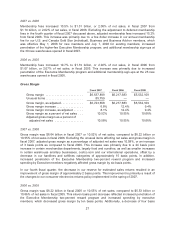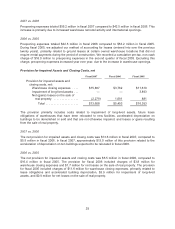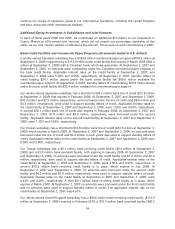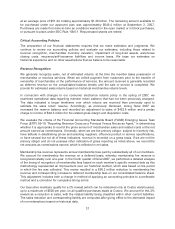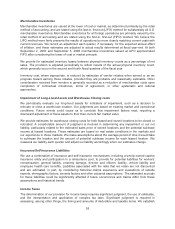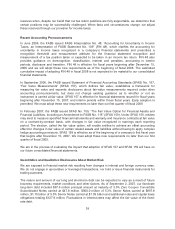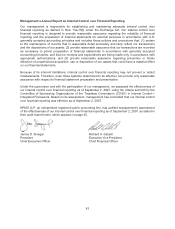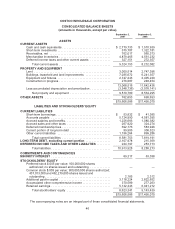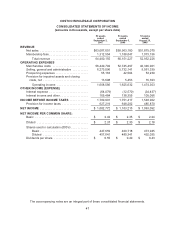Costco 2007 Annual Report Download - page 39
Download and view the complete annual report
Please find page 39 of the 2007 Costco annual report below. You can navigate through the pages in the report by either clicking on the pages listed below, or by using the keyword search tool below to find specific information within the annual report.at an average price of $51.44, totaling approximately $1.46 billion. The remaining amount available to
be purchased under our approved plan was approximately $646.4 million at September 2, 2007.
Purchases are made from time-to-time as conditions warrant in the open market or in block purchases,
or pursuant to plans under SEC Rule 10b5-1. Repurchased shares are retired.
Critical Accounting Policies
The preparation of our financial statements requires that we make estimates and judgments. We
continue to review our accounting policies and evaluate our estimates, including those related to
revenue recognition, merchandise inventory valuation, impairment of long-lived assets, warehouse
closing costs, insurance/self-insurance liabilities and income taxes. We base our estimates on
historical experience and on other assumptions that we believe to be reasonable.
Revenue Recognition
We generally recognize sales, net of estimated returns, at the time the member takes possession of
merchandise or receives services. When we collect payment from customers prior to the transfer of
ownership of merchandise or the performance of services, the amount received is generally recorded
as deferred revenue on the consolidated balance sheets until the sale or service is completed. We
provide for estimated sales returns based on historical merchandise returns levels.
In connection with changes to our consumer electronics returns policy in the spring of 2007, we
examined operational data regarding member return patterns that had not been previously analyzed.
The data indicated a longer timeframe over which returns are received than previously used to
estimate the sales return reserve. Accordingly, as previously disclosed, during fiscal 2007 we
increased the reserve balance and recorded an adjustment to sales of $452.6 million and a pretax
charge to income of $94.3 million for the related gross margin and disposition costs.
We evaluate the criteria of the Financial Accounting Standards Board (FASB) Emerging Issues Task
Force (EITF) 99-19, “Reporting Revenue Gross as a Principal Versus Net as an Agent,” in determining
whether it is appropriate to record the gross amount of merchandise sales and related costs or the net
amount earned as commissions. Generally, when we are the primary obligor, subject to inventory risk,
have latitude in establishing prices and selecting suppliers, influence product or service specifications,
or have several but not all of these indicators, revenue is recorded on a gross basis. If we are not the
primary obligor and do not possess other indicators of gross reporting as noted above, we record the
net amounts as commissions earned, which is reflected in net sales.
Membership fee revenue represents annual membership fees paid by substantially all of our members.
We account for membership fee revenue on a deferred basis, whereby membership fee revenue is
recognized ratably over one-year. In the fourth quarter of fiscal 2007, we performed a detailed analysis
of the timing of recognition of membership fees based on each member’s specific renewal date as this
methodology represented an improvement over our historical method, which was based on the period
in which the fee was collected. This review resulted in a $56.2 million reduction to membership fee
revenue and corresponding increase to deferred membership fees on our consolidated balance sheet.
This adjustment includes both a change in method of applying an accounting principle to a preferable
method and a correction for cumulative timing errors.
Our Executive members qualify for a 2% reward (which can be redeemed only at Costco warehouses),
up to a maximum of $500 per year, on all qualified purchases made at Costco. We account for this 2%
reward as a reduction in sales, with the related liability being classified within other current liabilities.
The sales reduction and corresponding liability are computed after giving effect to the estimated impact
of non-redemptions based on historical data.
37


